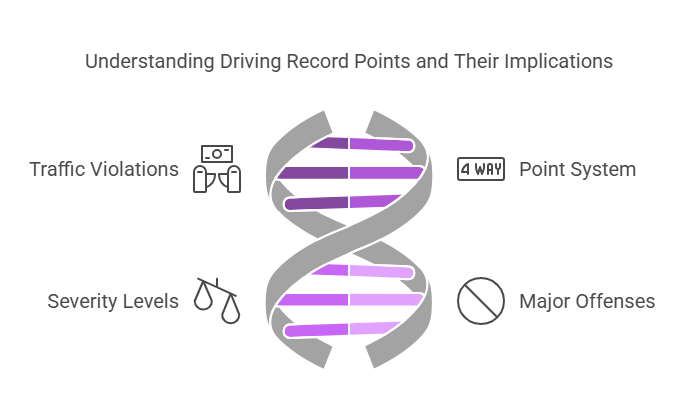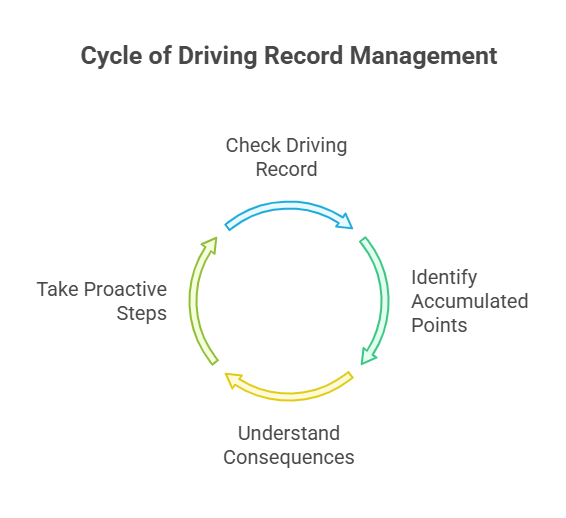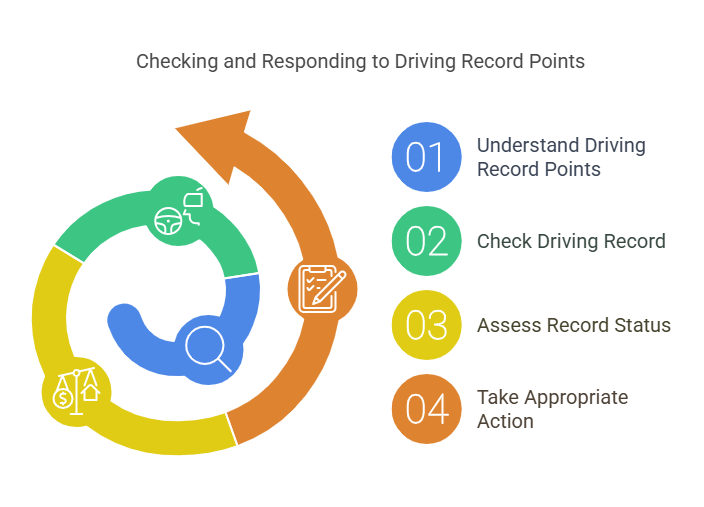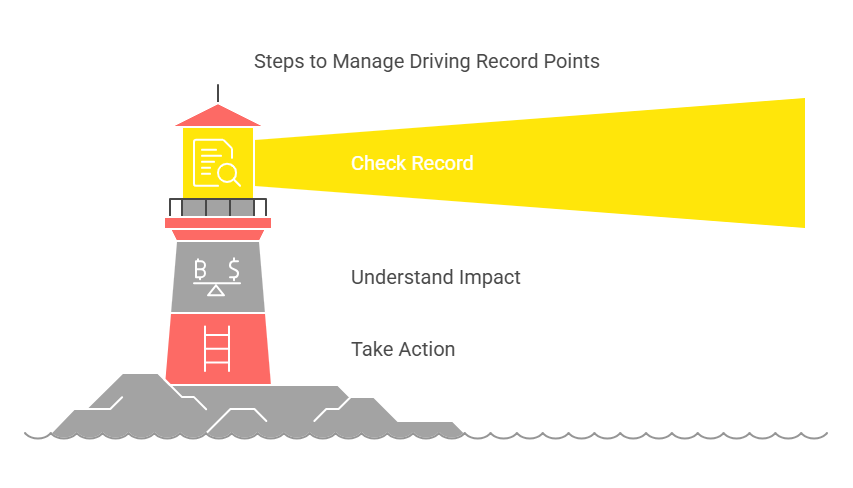Driving Record Points: What You Need to Know

Introduction to Driving Record Points and Why It’s Important to Check
Driving is a responsibility that comes with legal and financial consequences. In order to ensure the safety of all road users, states across the U.S. implement a point system to track drivers’ behavior and punish driving infractions. Points are assigned for various violations such as speeding, reckless driving, or driving under the influence (DUI). Over time, these points accumulate on a driver’s record and can impact various aspects of their life, from insurance rates to license suspension. For this reason, it’s crucial to understand how driving record points work and why you should regularly check your driving record.
In this first part of the guide, we will explore what driving record points are, how they are accumulated, and the importance of checking your record regularly. We will also discuss the different types of violations that can lead to points, how points affect your driving privileges, and why it’s crucial to stay on top of your driving history.
What Are Points on Your Driving Record?

A driving record point is an official notation on your driving history that indicates you’ve been convicted of a traffic violation. When a driver commits an offense, points are added to their record to reflect the severity of the infraction. Different violations carry different point values, with more serious violations like DUI or reckless driving generally resulting in higher point values.
For example, if you are caught speeding or running a red light, you could face a few points added to your record. In contrast, committing a more serious offense, such as driving under the influence of alcohol or drugs, could result in five points or more being added to your record. These points serve as a way for authorities to track your driving behavior and determine whether you are a high-risk driver.
While some states have a more lenient point system, others can have stricter rules, making it essential to understand your specific state’s regulations.
How Do Points Accumulate on Your Record?
Each state in the U.S. has its own system for assigning points, but they all function in a similar way. Points are added to your driving record each time you are convicted of a traffic violation. These violations could range from minor offenses, like failing to signal a lane change, to more serious offenses, like driving under the influence or causing a car accident.
Common Violations and Corresponding Points
While every state has its own guidelines for how points are assigned, the most common driving violations that typically lead to points on your record include:
| Traffic Violation | Points Added |
|---|---|
| Speeding (up to 10 mph) | 2 points |
| Speeding (11-20 mph over) | 3 points |
| Reckless driving | 4 points |
| Running a red light | 2 points |
| Driving under the influence (DUI) | 5 points |
| Driving without a license | 2 points |
| Hit and run | 4 points |
| Failure to yield | 3 points |
| Driving without insurance | 3 points |
| Texting while driving | 2 points |
It’s important to note that in some states, the severity of the violation may determine how many points are assigned to your record. For instance, in California, speeding may result in 1-2 points, while DUI offenses can add up to 6 points on your record. These points can remain on your record for several years, depending on the state and violation.
The more serious the violation, the more points are likely to be added. Over time, these points accumulate on your driving record and can affect various aspects of your driving privileges.
Why Should You Check Your Driving Record Regularly?

It’s important to check your driving record regularly to keep track of the points that accumulate. The point system has several consequences, which can have a direct impact on your ability to drive legally and affordably. By monitoring your record, you can take proactive steps to prevent major repercussions. Below are several reasons why checking your driving record regularly is essential:
1. Protecting Your License from Suspension
In most states, there is a threshold beyond which accumulating too many points will result in a suspension of your driver’s license. The point threshold for license suspension varies depending on the state’s laws and regulations, but it usually ranges from 8 to 12 points within a certain period. For example, in Texas, your driver’s license may be suspended if you accumulate 12 points in a year. If you reach this point threshold, you may have your license suspended for a period of time, which could severely disrupt your life.
By checking your driving record, you can stay ahead of any potential risk of suspension. If you’re nearing the threshold, you may want to consider taking a defensive driving course or contesting violations that may not be accurate.
2. Impact on Insurance Premiums
Your driving record is directly linked to the rates you pay for auto insurance. Insurers assess the risk you pose as a driver based on your driving history. If you have points on your record, especially from serious violations, you may find that your insurance premiums increase. This could cost you hundreds of dollars more annually.
Insurance companies typically check your driving record when setting your premiums, and if they find too many points, they may classify you as a high-risk driver. Regularly checking your driving record allows you to monitor the points that could increase your insurance costs. If you find any errors or outdated violations, you can correct them to prevent unnecessary premium hikes.
3. Employment Opportunities
For certain jobs, particularly those that require driving as a primary responsibility, employers often review driving records before hiring candidates. If you are applying for a commercial driving position or any job that involves operating a vehicle, the employer may check your driving history to ensure that you are a safe driver. Accumulating too many points on your driving record could jeopardize your ability to secure these jobs.
By staying on top of your driving record and keeping it as clean as possible, you can improve your chances of securing a position that requires driving.
4. Legal Consequences and Errors on Your Record
Mistakes happen, and sometimes you may find that points have been added to your record incorrectly. If a violation was wrongly applied to your record or if you believe you weren’t at fault, you have the right to dispute the violation. However, it’s much easier to address errors promptly if you regularly check your driving history. If you fail to review your record, you may miss the opportunity to correct any mistakes.
In addition to disputing errors, it’s important to monitor whether or not you have any pending violations or unpaid fines that may be impacting your driving record.
5. Avoiding Unexpected Consequences
Sometimes, drivers don’t realize the implications of accumulating too many points until it’s too late. By keeping track of your points, you can avoid situations where you may be caught off guard by an unexpected license suspension or increased insurance premiums. Checking your driving record regularly is a simple way to stay ahead of these potential consequences and take action early if necessary.
The Point System and License Suspension
The point system serves as a tool to keep track of driving behaviors, but it also plays a critical role in license suspension. If you accumulate too many points within a specific period (typically 12 to 24 months, depending on your state), your state’s Department of Motor Vehicles (DMV) may suspend your driver’s license for a set amount of time.
How Many Points Lead to a Suspension?
The point threshold for license suspension varies from state to state, but generally, if you accumulate 12 points or more within 12 months, you may face a suspension. For example:
- California: 4 points in 12 months, 6 points in 24 months
- Texas: 12 points in 12 months
- Florida: 12 points in 12 months
Consequences of Suspension
If your license is suspended, you could face significant inconveniences, such as:
- Inability to legally drive: You cannot legally operate a vehicle until your suspension is lifted, which can be problematic for daily commutes or work.
- Higher insurance premiums: After a suspension, insurance companies will often raise your rates significantly, considering you a high-risk driver.
- Reinstatement fees: To have your license reinstated, you may have to pay hefty fees, complete additional courses, or meet specific conditions set by your state.
How to Check Your Driving Record for Points and What to Do Next

we explored what driving record points are, how they accumulate, and why it’s important to check your driving record regularly. Now that you understand the significance of these points and the potential consequences, it’s time to walk through the process of how to check your driving record and what steps to take once you know the status of your record.
Knowing how to check if you have a point on your driving record can help you avoid issues with license suspensions, excessive insurance premiums, or job challenges due to a poor driving history. Whether you need your record for employment purposes, to dispute a violation, or simply to stay informed, understanding how to obtain it is a vital skill.
In this section, we’ll guide you through the process of requesting your driving record from various sources, highlight the different methods for checking it, and offer advice on how to handle points once you’ve confirmed their presence on your record.
Step 1: Requesting Your Driving Record from the DMV
The most official way to check your driving record is through the Department of Motor Vehicles (DMV) or the relevant motor vehicle agency in your state. Each state has different procedures for obtaining your driving record, but the process is generally simple and straightforward.
How to Request Your Driving Record
- Visit the DMV Website: Each state has its own DMV website, where you can request a driving record online. To find the specific website for your state, search for “[state name] DMV driving record request.” For example, if you’re in California, you would go to the California DMV website.
- Choose the Type of Record You Need: Most DMVs allow you to request different types of records, such as:
- 3-year driving history: Typically includes violations, suspensions, and accidents from the past 3 years.
- 7-year driving history: Includes a longer history and can sometimes contain more violations and accidents.
- Full history: A complete record that may go back to when you first received your driver’s license.
Select the type of record you need. Some records may also include information about any current or past suspensions.
- Complete the Request Form: Fill out the online form with your personal information, including your name, address, driver’s license number, and other identifying details to ensure that the record is accurate.
- Pay the Required Fee: There is usually a fee associated with obtaining a driving record. The cost varies by state, but it typically ranges from $5 to $30 depending on the type of record you request. Payment can be made through credit/debit cards or other online payment methods.
- Receive Your Record: After submitting the request, you may receive your driving record immediately if requested online. Alternatively, it may take a few days if you are requesting a physical copy or if your request needs to be processed manually.
Benefits of DMV Requests
- Official Source: Since it comes directly from the state, a DMV driving record is typically the most accurate and up-to-date record.
- Complete History: A DMV request will provide a complete driving history, including details on all violations, accidents, and points.
- State-Specific Information: Requesting through the DMV ensures that you get the correct record for the laws and regulations in your state.
Step 2: Using Online Services to Check Your Driving Record
If you prefer a quicker, more convenient way to check your driving record, there are numerous online services that allow you to access your driving history. These services can be particularly useful if you need your record immediately and don’t want to wait for the DMV to process your request.
How Online Services Work
- Choose a Reputable Service Provider: Some of the most popular third-party providers for checking driving records include services like Exact Background Checks, BeenVerified, Checkr, and IntelliCorp. These platforms specialize in providing detailed reports on driving histories, including points and violations.
- Sign Up and Provide Your Information: After selecting a provider, you’ll need to create an account and provide information such as your name, date of birth, driver’s license number, and the state in which you are licensed. Be sure to enter your information accurately to ensure that the record retrieved is yours.
- Select the Report Type: Similar to DMV requests, online services typically offer different types of reports. You can select a report for a specific time period (such as 3 years or 7 years) or request your complete driving history. Ensure you choose the report that best suits your needs.
- Pay the Required Fee: Most third-party services charge a fee for obtaining a driving record, with prices usually ranging between $10 and $50. The fee is often tied to the comprehensiveness and speed of the report.
- Instant Access to Your Record: Once you’ve completed the necessary steps, the driving record is often available instantly online. You can download the record in PDF form, print it, or save it for future reference.
Advantages of Online Services
- Speed and Convenience: Online platforms provide immediate access to your record without needing to wait for the DMV to process your request.
- Comprehensive Reports: Some third-party services provide additional features, such as a full background check, including driving history, criminal records, and employment history.
- Accessible Anywhere: As long as you have an internet connection, you can access your driving record at any time.
Step 3: Visiting a Local DMV Office
While online requests are the most common method, you can also obtain your driving record by visiting a local DMV office or an equivalent government agency in your state. This method is especially useful if you prefer face-to-face interactions or if you are unable to use online services.
Steps for In-Person Requests
- Locate Your Local DMV Office: Use the DMV website or call your state’s motor vehicle agency to find the nearest office. Many states allow you to schedule an appointment online to avoid long wait times.
- Gather Required Documents: Be sure to bring your driver’s license and any other necessary identification, such as your social security number or proof of address, depending on the DMV’s requirements. Check the DMV’s website in advance to ensure you have everything you need.
- Request Your Record: Once at the office, request a copy of your driving record. The staff will assist you in filling out any necessary forms. You may also need to provide your driver’s license number and some basic personal details to verify your identity.
- Pay the Fee: In-person requests usually involve a fee, which can vary based on the type of report you request. Be prepared to pay via cash, check, or credit card.
- Wait for Your Record: Depending on the office’s workload, you may receive your record immediately or it may take several days for the DMV to process your request. If your state provides an expedited service, you can often receive the report within a few hours.
Pros of Visiting a DMV Office
- Personal Assistance: If you have any questions or issues, you can directly speak with a DMV representative to get help.
- Official Record: Like the online request, an in-person request will provide you with an official, accurate record from the state.
What to Do if You Have Points on Your Driving Record

After you check your driving record and discover that you have accumulated points, there are several steps you can take to manage your record and reduce the risk of suspension or increased insurance premiums.
1. Take a Defensive Driving Course
In many states, completing a defensive driving course allows you to reduce points on your record or dismiss certain violations. These courses are designed to teach safe driving practices and refresh your knowledge of road laws. The course usually lasts for several hours and can be completed either in person or online.
2. Contest the Violation in Court
If you believe that the points on your record were added due to a mistake or wrongful conviction, you can contest the violation in court. Many violations can be challenged, especially if you have evidence to prove your innocence or if you feel the officer made a mistake.
3. Check State-Specific Point Reduction Programs
Some states offer point reduction programs to help drivers maintain a clean record. These programs may allow you to attend a defensive driving course or complete other requirements to have points removed after a certain period.
Comparing Methods of Checking Your Driving Record
| Method | Cost | Time Frame | Pros | Cons |
|---|---|---|---|---|
| DMV Website Request | $5 – $30 | Immediate to a few days | Official and accurate; various record types | May require waiting for processing in some cases |
| Online Service Providers | $10 – $50 | Instant Access | Fast, accessible, and convenient; comprehensive reports | Some services may not be as official as DMV |
| In-Person DMV Request | $5 – $30 | Immediate or 1-2 days | Direct interaction with DMV staff; official record | Can involve long wait times in some cases |
Legal Aspects of Points on Your Driving Record
Understanding the legal implications of points on your driving record is essential for avoiding serious penalties that can affect your driving privileges, insurance rates, and financial stability. Below are key legal aspects to consider regarding driving record points:
1. Point Accumulation and License Suspension
In most states, if you accumulate too many points on your driving record, you risk losing your driving privileges. Each state has different thresholds for point accumulation before a license suspension is triggered, but the general rule is that the more points you accumulate, the more likely you are to face a suspension or revocation of your driver’s license.
- Warning Period: Some states may issue a warning if you reach a certain threshold (for example, 6 points in a year) to give you the opportunity to take corrective actions like attending a defensive driving course.
- Suspension or Revocation: If you exceed the point limit (usually around 12 to 18 points), your license may be suspended for a certain period. Repeated offenses or particularly severe violations (e.g., DUIs) can lead to longer suspensions or even permanent revocation of your driving privileges.
- Time Frame for Accumulating Points: Points usually expire after a certain period, typically 2 to 3 years depending on the severity of the violation. After this time, they no longer count toward your total point accumulation. However, this varies by state and violation.
2. Insurance Implications
Points on your driving record can lead to higher insurance premiums. Insurance companies use your driving history to assess the risk of insuring you. The more points you have on your record, the higher the risk in their eyes, which usually translates into increased premiums.
- How Points Affect Your Rates: Each insurance company has its own way of assessing the risk associated with points. However, most companies will increase your rates if you have multiple points, especially for serious violations like DUIs or reckless driving.
- Insurance Surcharges: In some states, insurance companies may be required to apply a surcharge to your premiums if you have accumulated a certain number of points. The surcharge can last for several years, making it crucial to keep your record as clean as possible.
- Rate Reduction Programs: In some cases, you can take a defensive driving course or complete a state-approved driver improvement program to lower your insurance rates or offset points on your record.
3. Legal Rights and Disputing Points
If you believe that points on your driving record were added incorrectly or that a violation was unfair, you have the legal right to dispute the violation or points.
- Disputing Errors on Your Record: If there is an error in the way points were applied to your driving record (for example, you were wrongly ticketed or the violation was dismissed in court), you can contact your state’s DMV and request a correction.
- Court Challenges: If you disagree with a violation or believe you were wrongly penalized, you have the right to contest the violation in court. Successful challenges can lead to the removal of points from your record, which helps maintain your driving privileges and insurance rates.
- Expunging Records: In some cases, expungement is possible, where certain violations or points may be removed from your driving record. However, expungement laws vary by state, and not all violations are eligible for removal.
FAQs About Points on Your Driving Record
Let’s address some of the most commonly asked questions regarding points on your driving record:
What are driving record points and how do they accumulate?
Driving record points are official notations for traffic violations. They accumulate each time you're convicted of an offense, with different violations carrying different point values.
Why should I regularly check my driving record?
To protect your license from suspension, monitor and potentially lower insurance premiums, ensure employment opportunities, correct errors, and avoid unexpected legal consequences.
How many points lead to a license suspension?
The point threshold varies by state, but generally around 12 points within 12 months can lead to suspension. Check your state's DMV guidelines for specific information.
How can I check my driving record for points?
You can check through your state's DMV website, using online third-party services, or by visiting a local DMV office.
What can I do if I have points on my driving record?
You can take a defensive driving course, contest the violation in court, check state-specific point reduction programs, or, in some cases, petition for expungement.
What are driving record points and how do they accumulate?
Driving record points are official notations for traffic violations. They accumulate each time you're convicted of an offense, with different violations carrying different point values.
Why should I regularly check my driving record?
To protect your license from suspension, monitor and potentially lower insurance premiums, ensure employment opportunities, correct errors, and avoid unexpected legal consequences.
How many points lead to a license suspension?
The point threshold varies by state, but generally around 12 points within 12 months can lead to suspension. Check your state's DMV guidelines for specific information.
How can I check my driving record for points?
You can check through your state's DMV website, using online third-party services, or by visiting a local DMV office.
What can I do if I have points on my driving record?
You can take a defensive driving course, contest the violation in court, check state-specific point reduction programs, or, in some cases, petition for expungement.
Conclusion
Maintaining a clean driving record is critical not just for avoiding suspensions and keeping your insurance rates low but also for ensuring that you stay compliant with state regulations. By understanding the point system, regularly checking your driving record, and knowing your legal rights, you can manage your driving history effectively.
Here’s a summary of the essential points from this article:
- Points accumulate for traffic violations such as speeding, reckless driving, and DUIs. Too many points can lead to suspension or increased insurance rates.
- You can check your driving record through the DMV, online services, or by visiting your local DMV office. Each method has its own benefits and costs.
- It’s important to know how to handle points, whether through defensive driving courses, court challenges, or understanding state-specific programs.
- If you disagree with points on your record, you have the right to dispute errors and even petition for expungement in some cases.
By regularly monitoring your driving record and following the necessary steps, you can avoid penalties and ensure that you continue to enjoy safe and legal driving privileges.




I feel this is one of the such a lot significant info for me.
And i’m happy studying your article. But wanna statement on some
basic issues, The web site taste is perfect, the articles is really great
: D. Just right job, cheers https://menbehealth.wordpress.com/